New Orleans Second Line Parade
If you clicked the audio icon, what you are hearing is the underlying rhythm of the Second Line Parade for Kufaru. Master percussionist Kufaru died the second week of June. Kufaru was a popular New Orleans musician who has recorded with the Neville Brothers, Emmy Lou Harris and others. He was a generous man who gave back to his community and was well-loved for it. In his honor his friends and family held a second line parade.
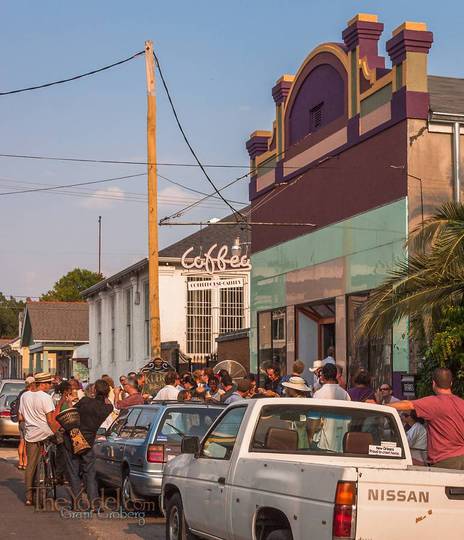
A second-line parade has it's roots in the New Orleans jazz funeral. They carry on many of the same traditions leaving out the casket, the mourners and the visit to the cemetery. The second-line for Kufaru was set to start in the Marigny district at the Caffeo coffeehouse and gallery.
I arrived at Caffeo about a half-hour before the scheduled start time of 6pm. An excellent Latin band was playing as people crowded in and out of the room, ordering coffee and helping themselves to the red beans and rice that were set up in the corner. It was a gathering of friends and acquaintances, everyone knew each other and the sounds of conversation wove in and out of the salsa music making a pleasant, musical cacophony. Outside in the street, people were milling about enjoying the warm evening. Many of them were carrying instruments, drums or things to bang on.
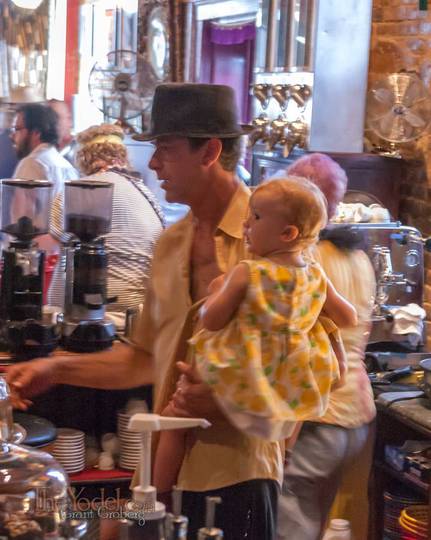
The name second line refers to the "second line" of participants in the parade. Fans and friends of the players, the music, and the event. The second line parade is not the common kind of parade that Americans are accustomed to. You don't just stand there and watch the parade pass. In a second line parade you participate. You join in and follow. Whether you choose to walk or dance, join in and be part of the crowd. These are wild, open air occasions that have been described as block parties that move block to block. People will see the line coming down their street and join in and follow it to its conclusion.
The tradition of the second line parade comes down from the 1800's when African Americans, not having access to insurance, formed mutual aid societies to insure all of their members received a proper burial or could get assistance through difficult times. These societies were called "Social Aid & Pleasure Clubs." The parades are thought to have originated as a form of advertisement for the clubs to increase membership and to honor members who had died. As the 20th century passed and more mainstream insurance and other services became available to black New Orleanians the Social Aid and Pleasure Clubs persisted. Since they were no longer providing services, they dropped the "Aid" in the description and are now known as "Social and Pleasure Clubs." It is these Social and Pleasure Clubs that sponsor a Second Line parade. As the sponsor, the clubs are known as the "Main Line."
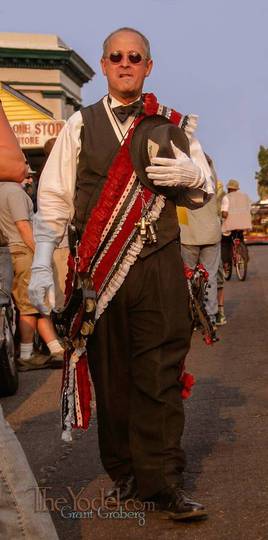
As far as I could determine, The Storyville Stompers were the main line for this parade. At least that is the name I read on the side of the one of the bass drums. The Storyville Stompers were gathering at the corner by the coffee house. The conductor was adjusting his finery. Slowly the mob seemed to coalesce into a structure of sorts with the Brass of the Stompers at the lead, followed by the bands percussion. Immediately after was a group of percussionists tailed by a motley group of musicians, bangers and the rest of the Second Line.
The conductor blew his whistle, the bass drum went thump, thump, thump, and the music began. A wild version of a traditional gospel ditty. Amid the chaos of sound the melody wove about, rattling down the street, sounding out for blocks around the parade was on it's way.
The procession began. This is not marching band music and nobody was marching. Most were dancing a shuffle-step known, understandably, as a second-line, using both heel and toe to mark the rhythm of the beat. a few were leaping wildly about. At the head of the parade danced a person on stilts, completely covered in a costume of golden yellow set off by a grass skirt, a mask that covered their entire head, a mirrored, feathered cap and two hair wands.
The procession turned at the first corner and then at the next. It was a slow and winding route designed to take the longest way between two points. After a few blocks everything and everyone stopped. A moment of silence and the dirge began. "Just a Closer Walk with Thee" at a tempo almost as stationary as the players.
This was a serious moment. Tears were flowing here and there as people felt the loss of their friend. The procession began again at a slower pace. After, perhaps, three minutes of the dirge, the players at the front began singing while the sousaphone kept up it's "blalooming." A few minutes of singing inspired the drummers to began adding a slow back-beat . A clarinet sailed in, adding as many embellishments as the slow tune would allow. The other players joined one by one. The song began to take on a feeling of impatient restraint. Life is sorrowful, but it is too short to be without joy for long. With a drum roll and a "poom," the song ended.
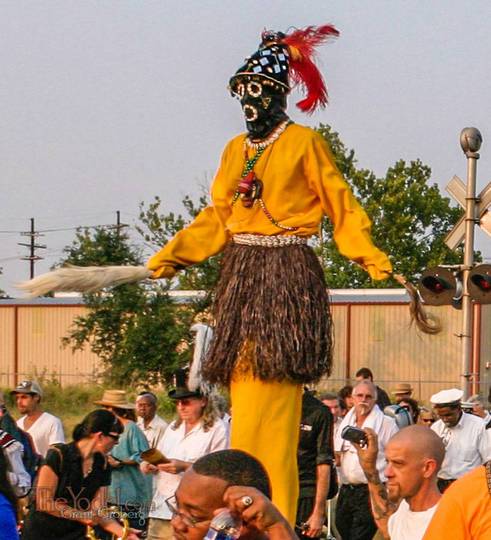
The conductor counted off a quick four and once again "Just a Closer Walk with Thee" spun out into the air, upbeat and happy and the Second Line moved on once again. The people dancing danced, the leapers leaped, and the people who shuffled and stepped shuffled and stepped to the happy tune.
A few blocks later the Band was playing "I'll Fly Away," the crowd joined in singing and the band backed off to the lightest form of accompaniment while everyone sang a few verses backed by the water of the percussionists.
I wonder how Hurricane Katrina has affected the Social and Pleasure Clubs. With so many people spread all over the country and starting new lives elsewhere what will happen to the Second Line parades that, in better times, happened all year 'round? At best, Hurricane Katrina helped to inoculate the entire country with the spirit of New Orleans. Imagine, in the next few years Social and Pleasure Clubs popping up all over the place. Second Line parades will be taking place in Cleveland, Salt Lake City and Boston. Staid Midwesterners will change out of their overalls, dress in bright array and dance down the street.
Just before sunset the Second Line parade reached a crossroads. There was a café and a bar here. Traditionally, second line parades are routed to pass by and stop at bars along the route. This isn't so that everybody can remain drunk, but to provide people with a chance to get some food, water and use the bathroom. This is New Orleans, it is hot here, people have been dancing and sweating. It also allows the owners of the establishments to make a few extra dollars off of the parade attendees. In olden days Bar owners would sponsor the parade to bring extra traffic to their establishment.
I suspect what happened next might not be typical for a second line but was more a part of the celebration of the percussionist Kufaru. Also, by this point I had stopped taking pictures. The light was poor, I am not big on flash nor am I one of those people who prefers to live behind/through a lens. Sometimes you need to put the camera away and be there. I apologize for no pictures of the following.
The crowd was now numbering two hundred or so and completely occupied the crossroads with impunity. The brass players had stopped playing but the percussionists never let up their cadence. They made a circle at the center of the crossroad and changed the rhythm of what they were playing. A more elemental rhythm that pulsed and moved through the crowd. Two women emerged from the crowd as if they were expected and this was their part to play. They began dancing to the drums in the center of the circle rolling their heads and waiving their arms. The percussionists drummed to the women's movements as much as they danced to the beat of the drums. Deeper and stronger the dancers and drumming entwined. The crowd was captivated as well and even the Bermuda-clad Tourist-- camera slung around his neck like an albatross--couldn't help but twitch his hand to the beat.
It was just before the moment of the sun touching the horizon. One of the women danced harder. 'Round and 'round working herself deeper into the trance-state of the beat which grew more fervent. As the Sun began the touch, She danced lower and lower to the ground, a beer was opened and poured out onto the ground. Sacrament. A few more minutes of the ritual and the dance and the woman cleansed the area with a different dance movement, this time facing out of the circle, twitching each shoulder in succession and then throwing her hands up as if casting sand into the air. More people moved into the circle to dance.
The stilt walker came in and after a bit opened up the circle, motioning people back with his wands. He began a dance of his own, balancing and spinning on first one than the other of the four-foot poles he stood upon. He danced with the two women. Each performing a shimmy that took her between his legs. He then brought in other women from the edge of the circle inviting them to dance between his legs. They danced between and across the circle. One was a young woman whose boyfriend couldn't turn off his video cam. He'll return home with a shaky, poorly lit video of a place he was viding, She'll return home having danced in a sacred circle in New Orleans, who brings home more?
The drumming continued The stilt walker motioned to someone known to him to enter the circle, a man in a wheelchair with a tambourine. The person helping him pushed him into the circle and they navigated through the legs of the stilted one.
After about 45 minutes of the sunset ceremony the cadence of the percussionists changed, band members started gathering again. And with a whum pum pom, the Second Line parade was off again and the crossroads were returned to ordinary traffic.
Second Line parade routes typically stick to slow back streets where car traffic is never an issue. Every once in a while you have to cross a larger street. The route of this parade took us to cross Elysian Fields, a large four-lane road. The cars had no choice but to wait and wonder at the harlequin crowd of three-hundred or so people, some leaping, others skipping, passed before their windshields. A colorful event that happens only in New Orleans. Ah, such a way to get stuck in traffic.
The second line ended at a place called Cafe Brasil. The band marched right into the club and up onto the stage where they continued to play a short set. There were people waiting at Cafe Brasil: older folk who's days of dancing through the street in the heat are behind them, people with children and folks who were helping with the event. Food had been set up outside and once again, the crowd took over the street as the celebration continued inside and outside.
The percussionists had remained outside and formed a circle in the intersection. The undulating beat curled down the street. Sometimes there would be singing other times the drums alone were enough. A crowd had gathered to watch as people would enter the circle to dance. One couple performed an animalistic pursuit of each other; a man in dreadlocks went into a trance dance; two women dressed in white danced around a candle. All around, the crowd bobbed it's collective head and spontaneous dancing would break out here and there.
Inside Café Brasil music thundered. The band was constantly shifting as musicians would come on to play a few songs for their friend. Against one wall was a shrine for Kufaru. There were candles and incense. People would come up and stand before the display. On it were his conga drums and other percussion instruments. Some of his shirts were hung and other mementos of his life were displayed. Arrays of photographs lined the bottom and back of the area. This was the man who's life was being celebrated in such a joyous manner.
It is said that we are only alive through our contact with others and that the size of a person's life is measured by the number of hearts they touch. If this is so, Kufaru lived the life of a giant. In his 56 years Kufaru traveled widely and gave of himself fully wherever he was. In love with life, he lives on in the hearts of all who knew him.

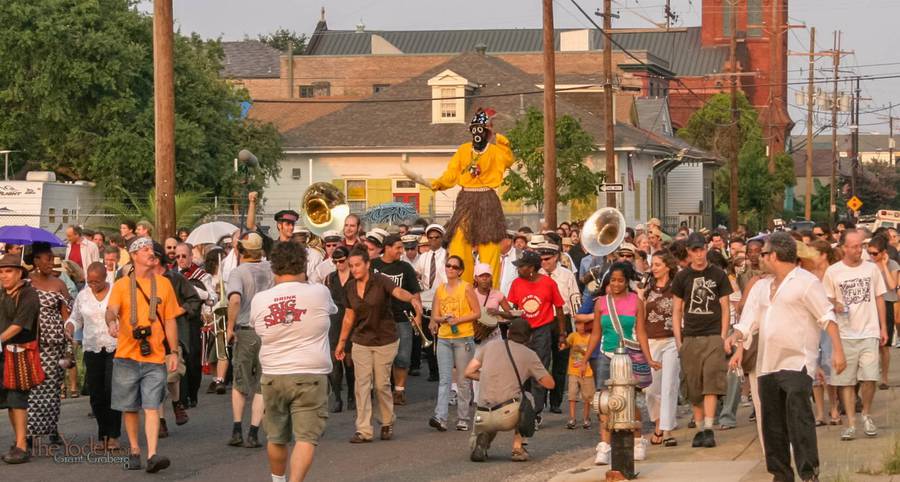
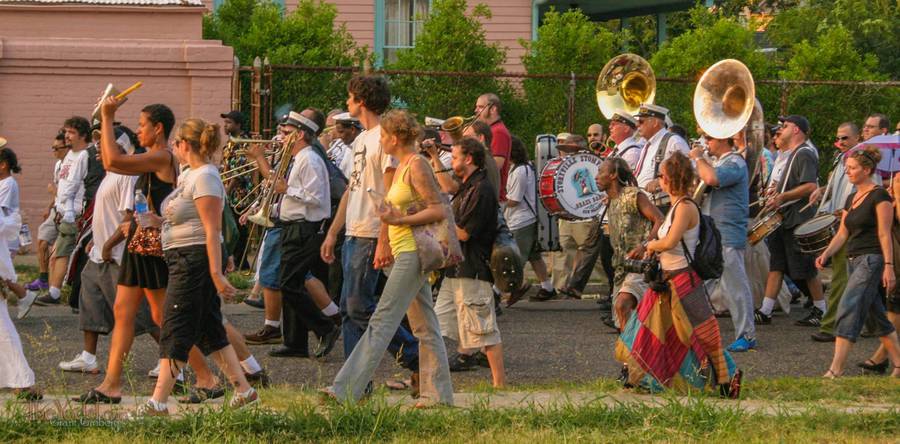
 New Orleans Second Line Parade
New Orleans Second Line Parade